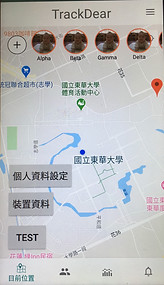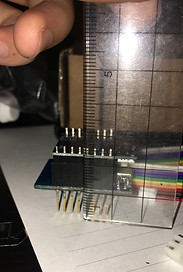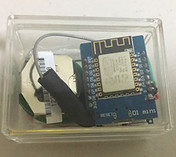Tracking Your Dear...
TrackDear

Team Member
Individual
My Role
Entire project from research to front-end and back-end system design, create database, IoT device and App UI design
Project Time
2 years
Tools
Adobe XD
Android Studio
Visual Studio
MSSQL
Ardunio
Photoshop
Background
I came up with this idea since population aging is very serious in Taiwan. The children are all working in other places, resulting in many cases of the elderly living alone, so that safety and getting lost have become one of the current social problems.
Goal


Develop a wearable device and an application that can track the location at any time, helping people more easily take care of family members not only the elderly but also pets and children, so that taking care is no longer a burden.
App Design Process
Through questionnaires, it helps me to better plan my design, understand what the user's needs and goals are, and what kind of user interface needs to be provided. I placed features on the navbar that the main target users think they need, so that they can easily switch pages to complete their goals.
Moreover, I set a map of the device location as the homepage because that is the most important goal of the user. I also use the this map as the background of other pages, so that even if users switch to another page, they can see the location of the device at any time.


In the initial stage of app development, each function in the app was built and tested separately. Confirm that the most important function is that the data collected by the device is reflected in the app.
I connected the Google Maps API to the application. When testing, I first let the device only send location data once so I could compile error conveniently.
The blue dot is the current location of me (the device manager), and the red icon is the location where the device has been in the past.


Later, I added a double RecyclerView to display the image and name of managers and devices. People can see the location of the device by clicking on it.
I make sure that the device is fully functional, and then finally adjust the app interface to make the app more aesthetically pleasing.

Device Design Process
The most important part of this project is the design of the device and its final operation in the App.

ATGM332D-5N31 GPS sensor

ESP8266 WeMos D1 mini wifi sensor
The two important sensors: GPS sensor and Wifi sensor.
At the beginning, I independently tested whether the GPS sensor was functioning properly, and confirmed the type, frequency and stability of the returned data.


After the GPS sensor is connected, the data string returned.

Next, test whether the Wi-fi sensor can connect to the designated network normally.
Connect the GPS sensor to the Wi-fi sensor and start testing whether the collected location data can be successfully transmitted to the database through the Wi-fi.
The purpose of this step is so that the device can be carried alone without relying on a computer to transmit data.
After connecting the Wi-fi sensor and the GPS sensor, connect the lithium battery and put it into the box for the first outdoor test.



After testing the stability of the device for a long time, the frequency of data returned was adjusted to be returned once every 10 sec, and only necessary data fields such as longitude and latitude were returned to the local database.
Data fields: device num, date, time, latitude, latitude degree...
Finally, confirm how the length, width and height of the final device should be assembled and placed so that the device will have the smallest size.




Combine the GPS sensor, Wifi sensor and battery


Size: 1.3cm*2cm*2cm Weight: 53g


The device final look

TrackDear Trailer
Reflection
During the final testing phase of the device, In terms of weight, it didn't quite live up to our expectations. Even though the ideal weight of the device for the user is already known through literature review and previous user pre-testing, the lightest weight of the chips required in the entire device cannot be selected due to cost considerations. In the future, if the budget is sufficient, different chips can be tried to achieve a better user wearing experience.
After actual testing by target users, based on multiple comparisons of speed, distance and time, the location data was set from every 5 minutes, every 1 minute, and finally adjusted to return the location once every 10 sec as the optimal data collection density.
In addition, considering that tracking users involves very personal privacy issues. The credibility of the database will greatly affect the user experience, so I was very careful when designing the database. When I designed the database, I chose to use MSSQL to create a local database instead of a cloud database to reduce the possibility of user personal information being leaked and increase user trust in the system.